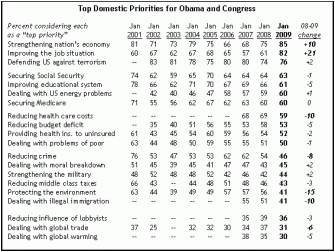Pew: Global Warming Dead Last Among Public Priorities

Call it a case of extreme optimistic bias: Many climate advocates point to polls that show when the public is asked directly, a majority say they are “concerned” about global warming and favor action. But what’s missing from this poll assessment is where global warming sits relative to other political priorities. When you examine this comparison, public support for action turns up as soft, even among Dems and Independents, suggesting that it will be very difficult for Obama to rally the needed public input to pass meaningful legislation through Congress.
One way to assess the strength of public resolve on the issue is to see where global warming or the environment sits in the classic open-ended question asking the public to name the most important problem facing the nation, or alternatively what the President and Congress should focus on. As I noted a few weeks ago, global warming and the environment surfaces as a top of mind priority among just 1% of respondents compared to more than 40% who say the economy.
Pew offers a different and more revealing comparison. On more than 20 issues, the polling organization asks respondents to agree or disagree whether each should be a “top priority” for the president and Congress. For the past three years, global warming has been a bottom tier issue, with fewer Americans agreeing it should be a “top priority” than most other issues. This year, in an analysis released today, as depicted above, it ranks dead last.
In the context of an economic recession and two wars, absent a shift in the polls and a surge in input from a diversity of constituents, it is unlikely over the next four years that a strong majority in Congress will make climate change a top agenda priority or be willing to take the political risk to pass major policy initiatives. Indeed, climate change threatens to become for Obama what immigration reform was for former President George W. Bush.
In 2007, the White House and leaders in Congress had reached a consensus on immigration policy and polling showed a favorable public. Yet soft majority support in the surveys could not trump the strong opinion intensity of minority opposition, especially when it was mobilized by conservative media outlets and leaders. For fence sitters in Congress, the voice of the public that was loudest–via phone calls, emails, and letters–was that of opponents to immigration reform
At his blog Dot Earth, the NY Times Andrew Revkin has additional thoughts on the climate communication challenge with more to follow in print later this week.
I have an article forthcoming that explores this communication challenge in more detail, but if you are a reader of this blog, you can guess what’s at the core of my analysis. Put simply, the problem has little to do with science literacy, a lack of respect for science, poor reporting on the part of journalists, or a decline in the science beat at news organizations. Indeed, it’s time to stop blaming the public, journalists, and the media.
The communication burden instead rests with political leaders, scientists, advocates, and policy experts. Only by “reframing” the relevance of climate change in ways that connect to the specific core values of key segments of the public – and repeatedly communicating these multiple meanings through a variety of trusted media sources and opinion leaders- can the Obama administration and allies generate the widespread public engagement needed to move major policy action forward. This shift in public outreach, however, will first take a re-examination of the assumptions that have traditionally informed climate change communication efforts.
it’s time to turn the page on the “war on science,” “inconvenient truths,” and “denier” rhetoric that were battle cries for the Left during the Bush administration and 2008 election. These public accountability frame devices rally the base and appeal to emotions, but they are also likely to be re-interpreted among the wider public as just more elite rancor.
It’s also time to stop focusing narrowly on remote polar impacts, looming environmental disaster, or symbols such as polar bears. These examplars are either not personally relevant enough to most audiences, are dismissed as remote and far off in the future, or easily re-framed as “alarmism” sending interpretations back into the mental box of lingering scientific uncertainty.
Not every citizen cares about the environment or defers to the authority of science, yet among climate change advocates, these mental points of reference continue to be the dominant emphasis. In order to generate widespread public support for meaningful policy action, the communication challenge is to figure out how to shift the climate change focus away from the traditional frames and devices towards a new perceptual context that resonates with the values and understanding of a specific intended audience. These new meanings for climate change are likely to be key drivers of public resolve and eventual policy action.
Last summer at Big Think (video below), I previewed this climate change communication challenge and some of the emerging new meanings that are likely to unlock public engagement. Stay tuned for more on this in an upcoming article. [Update: Video embedding at Big Think is currently down. Will repost embedded video when available]




